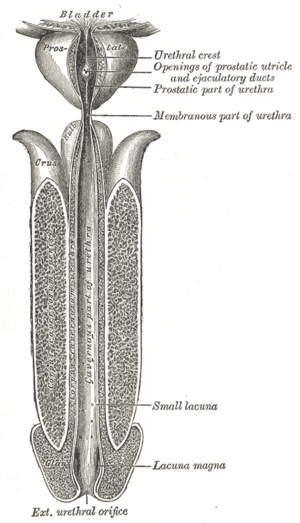Urethral stricture
| Urethral stricture | |
|---|---|
 |
|
| Urethra is tube at center. | |
| Classification and external resources | |
| Specialty | urology |
| ICD-10 | N35 |
| ICD-9-CM | 598 |
| DiseasesDB | 13562 |
| MedlinePlus | 001271 |
| eMedicine | med/3075 |
| MeSH | C12.777.767.700.700 |
A urethral stricture is a narrowing of the urethra caused by injury, instrumentation, infection and certain non-infectious forms of urethritis.
The hallmark sign of urethral stricture is a weak urinary stream. Other symptoms include:
Some patients with severe urethral strictures are completely unable to urinate. This is referred to as acute urinary retention, and is a medical emergency. Hydronephrosis and renal failure may also occur.
Urethral strictures most commonly result from injury, urethral instrumentation, infection, non-infectious inflammatory conditions of the urethra, and after prior hypospadias surgery. Less common causes include congenital urethral strictures and those resulting from malignancy.
Urethral strictures after blunt trauma can generally be divided into two sub-types.
Other specific causes of urethral stricture include
Urethral dilation and other endoscopic approaches such as direct vision internal urethrotomy (DVIU), laser urethrotomy, and self intermittent dilation are the most commonly used treatments for urethral stricture. However, these approaches are associated with low success rates and may worsen the stricture, making future attempts to surgically repair the urethra more difficult.
A Cochrane review found that performing intermittent self-dilatation may confer a reduced risk of recurrent urethral stricture after endoscopic treatment, but the evidence is weak.
Urethroplasty refers to any open reconstruction of the urethra. Success rates range from 85% to 95% and depend on a variety of clinical factors, such as stricture etiology, length, location, and caliber. Urethroplasty can be performed safely on men of all ages.
In the posterior urethra, anastomotic urethroplasty (with or without preservation of bulbar arteries) is typically performed after removing scar tissue.
In the bulbar urethra, the most common types of urethroplasty are anastomotic (with or without preservation of corpus spongiosum and bulbar arteries) and substitution with buccal mucosa graft, full-thickness skin graft, or split thickness skin graft. These are nearly always done in a single setting (or stage).
In the penile urethra, anastomotic urethroplasties are rare because they can lead to chordee (penile curvature due to a shortened urethra). Instead, most penile urethroplasties are substitution procedures utilizing buccal mucosa graft, full-thickness skin graft, or split thickness skin graft. These can be done in one or more setting, depending on stricture location, severity, etiology and patient/surgeon preference.
...
Wikipedia
